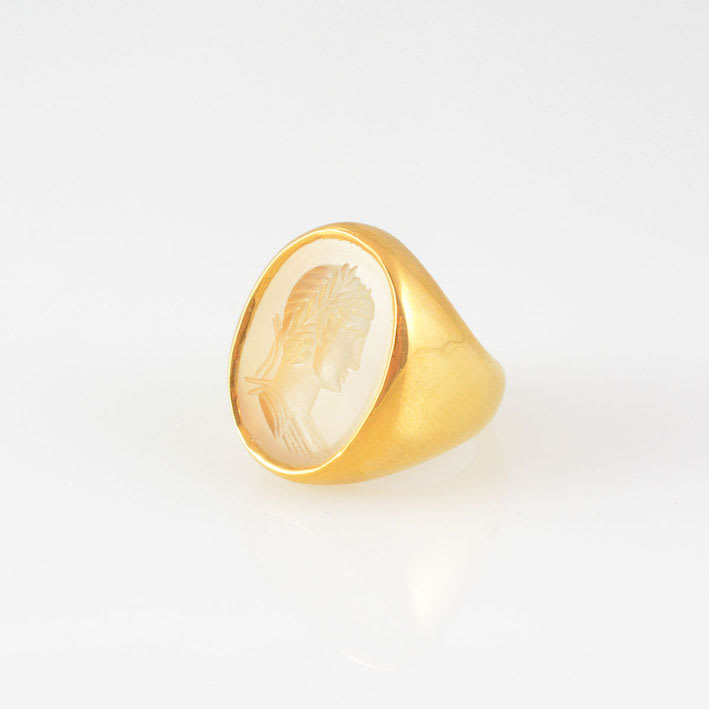Classical Revival Intaglio of a Roman Emperor, 1700 CE - 1800 CE
Carnelian/Gold
FJ.6339
This Intaglio is Set in a 24 Karat Gold Ring The art of glyptics, or carving on colored precious stones, is probably one of the oldest known to humanity. Intaglios,...
This Intaglio is Set in a 24 Karat Gold Ring
The art of glyptics, or carving on colored precious stones, is probably one of the oldest known to humanity. Intaglios, gems with an incised design, were made as early as the fourth and third millennia BC in Mesopotamia and the Aegean Islands. They display a virtuosity of execution that suggests an old and stable tradition rooted in the earliest centuries. The tools required for carving gems were simple: a wheel with a belt-drive and a set of drills. Abrasives were necessary since the minerals used were too hard for a metal edge. A special difficulty of engraving intaglios, aside from their miniature size, was that the master had to work with a mirror-image in mind.
When seeing an intaglio as lovely as this one, it is easy to understand the passion the aristocracy of the eighteenth century had for jewelry done in the antique style. Engravers often referred to classical models of ancient statuary and coins for inspiration. The beautiful head on this intaglio is very much like the heads of emperors on coinage, with the face seen in profile and wearing a laurel wreath as a sign of office. Though this particular emperor cannot be positively identified, he seems to represent the most admirable qualities a great ruler-- nobility, compassion and a special radiance enhanced by the gorgeous yellow light of the carnelian. To wear this ring brings together artistry and high style, sparkling like the sunlight on glittering gold.
The art of glyptics, or carving on colored precious stones, is probably one of the oldest known to humanity. Intaglios, gems with an incised design, were made as early as the fourth and third millennia BC in Mesopotamia and the Aegean Islands. They display a virtuosity of execution that suggests an old and stable tradition rooted in the earliest centuries. The tools required for carving gems were simple: a wheel with a belt-drive and a set of drills. Abrasives were necessary since the minerals used were too hard for a metal edge. A special difficulty of engraving intaglios, aside from their miniature size, was that the master had to work with a mirror-image in mind.
When seeing an intaglio as lovely as this one, it is easy to understand the passion the aristocracy of the eighteenth century had for jewelry done in the antique style. Engravers often referred to classical models of ancient statuary and coins for inspiration. The beautiful head on this intaglio is very much like the heads of emperors on coinage, with the face seen in profile and wearing a laurel wreath as a sign of office. Though this particular emperor cannot be positively identified, he seems to represent the most admirable qualities a great ruler-- nobility, compassion and a special radiance enhanced by the gorgeous yellow light of the carnelian. To wear this ring brings together artistry and high style, sparkling like the sunlight on glittering gold.



